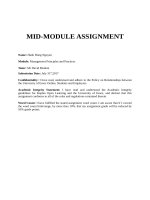Hiiriing_ For A Perfect Fiit.
Bạn đang xem bản rút gọn của tài liệu. Xem và tải ngay bản đầy đủ của tài liệu tại đây (88.63 KB, 19 trang )
H
H
i
i
r
r
i
i
n
n
g
g
…
…
F
F
o
o
r
r
A
A
P
P
e
e
r
r
f
f
e
e
c
c
t
t
F
F
i
i
t
t
www.xbcoaching.com
Page 1
H
H
i
i
r
r
i
i
n
n
g
g
…
…
F
F
o
o
r
r
A
A
P
P
e
e
r
r
f
f
e
e
c
c
t
t
F
F
i
i
t
t
by Kathi Graham-Leviss © 2001
www.xbcoaching.com
An e-book for those leaders responsible for hiring and placing
new employees effectively within the organization.
H
H
i
i
r
r
i
i
n
n
g
g
…
…
F
F
o
o
r
r
A
A
P
P
e
e
r
r
f
f
e
e
c
c
t
t
F
F
i
i
t
t
www.xbcoaching.com
Page 2
Introduction
In today’s ever-volatile workplace, we see an increasing need to hire and place new employees
with greater effectiveness than before. There are no longer time or budget allowances that give
us the flexibility to interview and hire other employees if the first person does not work out as
planned. What this means is our plan must work right the first time.
What that would entail is understanding how the potential employee thinks, acts, is motivated and
functions under stress. An impossible task? No!
It begins with talent. Obviously, you want to hire (and retain) those who bring the most and best
talent to your team. Here you will find the information and tools you need in order to hire those
talented individuals who are also behaviorally and characteristically a “perfect fit” with your
organization.
With the information contained in this e-book, you will have the tools to hire employees to fill
some of the most common positions in your organization. You will be able to do so effectively,
with greater assurance that the employee will function well in his/her new role, and with a better
understanding of that employee’s loyalty/longevity to the company.
Through the use of my four-step process; the DISC Behavioral Model; and the Personalities,
Interests, Attitudes and Values profile; we will examine ways to perform enlightening interviews
with tremendous results.
XB Coaching, Inc. offers both of these assessments (along with dozens of others) at
www.xbcoaching.com.
H
H
i
i
r
r
i
i
n
n
g
g
…
…
F
F
o
o
r
r
A
A
P
P
e
e
r
r
f
f
e
e
c
c
t
t
F
F
i
i
t
t
www.xbcoaching.com
Page 3
T
T
a
a
b
b
l
l
e
e
o
o
f
f
C
C
o
o
n
n
t
t
e
e
n
n
t
t
s
s
Chapter One An Overview of the DISC Model
Chapter Two An Overview of the PIAV Model
Chapter Three The 4-Step Process For Perfect Hiring
Chapter Four Hiring Customer Service Representatives That Are A Perfect Fit
Chapter Five Hiring Sales Representatives That Are A Perfect Fit
Chapter Six Hiring Sales Managers That Are A Perfect Fit
Chapter Seven Hiring Department Managers That Are A Perfect Fit
Chapter Eight Hiring Executives That Are A Perfect Fit
H
H
i
i
r
r
i
i
n
n
g
g
…
…
F
F
o
o
r
r
A
A
P
P
e
e
r
r
f
f
e
e
c
c
t
t
F
F
i
i
t
t
www.xbcoaching.com
Page 4
C
C
h
h
a
a
p
p
t
t
e
e
r
r
O
O
n
n
e
e
-
-
A
A
n
n
O
O
v
v
e
e
r
r
v
v
i
i
e
e
w
w
o
o
f
f
t
t
h
h
e
e
D
D
I
I
S
S
C
C
M
M
o
o
d
d
e
e
l
l
The DISC Behavioral Model is a measurable tool that helps to define observed behavior. What
exactly does that mean? It provides a way for you to assess the various ways people behave
under certain circumstances, their motivators, their most natural attributes, their behavior in the
work environment, and their preferred communication styles.
All this information can be used to create a “best fit” for employees who interview for positions at
your company.
DISC is an acronym that stands for Dominance, Influence, Steadiness and Compliance. These
are the four “core” behaviors that all people can be categorized by. There are – by all means –
many combinations of the four styles, and that is what makes us all unique.
Each behavioral type is comprised of all four styles,
with one being the “core” style which displays the predominant behavior.
By defining which style(s) your applicants possess, you will be better able to make that perfect fit.
Let’s take a few moments to briefly review each style and some characteristics of it. With this
information, you will be able to implement the suggestions for hiring made in each chapter within
this e-book.
Dominance – Individuals who show a high Dominance style are those that tend to process
quickly and are focused on tasks. These individuals tend to be results-oriented, focused on
challenge and power, and like to make decisions quickly with confidence. They are the team
members who you know will get the job done.
Those who fall into the Dominance category are most likely managers and corporate officers.
Some descriptors of this style include: driving, demanding, aggressive, pioneering and
competitive. They are goal driven and enjoy a personal challenge.
When communicating with this style observe the following:
• Be direct, brief and to the point.
• Focus on the task and stick to business.
• Take a results-oriented, logical approach.
• Identify opportunities or challenges.
• Provide a win/win situation.
• Do not touch. Keep your distance.
When you receive communication from someone who is high in Dominance, it could appear
short, undetailed, overpowering, intimidating, insensitive to feelings, or lacking in patience. You
may need to ask for additional information as Dominance types often communicate in short
bursts.
Some contributions Dominance styles make to the team are:
• solving problems
• driving for results
• positive
• powerful and authoritative
Some limitations to be wary of with this style are:
H
H
i
i
r
r
i
i
n
n
g
g
…
…
F
F
o
o
r
r
A
A
P
P
e
e
r
r
f
f
e
e
c
c
t
t
F
F
i
i
t
t
www.xbcoaching.com
Page 5
• overstepping boundaries
• use of fear as a motivator
• lack of listening skills
• lack of tact
• unhappy with “routine” work
• over delegates, under instructs
Influence – Individuals who show a high influence style are those who tend to process quickly
and are focused on people. They are the team members who keep things exciting and
keep everyone motivated. Recognition, relationships, and freedom from details will likely
motivate them.
The primary corporate vocations for those high in Influence are sales and customer service.
Charismatic, inspiring, optimistic, outgoing and animated describe these types. They are driven
by their desire to socialize with people.
Those who are high in Influence prefer the following when being communicated with:
• Allow time to socialize.
• Lighten up and don’t be afraid to have fun.
• Ask for feelings and opinions.
• Involve them in brainstorming.
They have a need to verbalize. They also lack attention to detail, appear superficial, have poor
follow-through and can appear manipulative. Influencers most likely will talk “around” a subject
until they are able to make their point. You may find yourself exercising a lot of patience with
Influencers.
Some contributions this style brings to the team are:
• social and verbal aggressiveness
• optimism
• good persuasion skills
• vision of the big picture
• people-oriented
• team-oriented
Some limitations to be wary of with this style are:
• impulsiveness
• unrealistic in appraising people
• lack of attention to detail
• disorganized
Steadiness – Individuals who show a high Steadiness style are those that tend to process more
methodically and who are focused on people. These individuals tend to be loyal, cooperative,
calm and methodical in how they deal with life. They are the team members who make sure
that everyone on the team is doing OK. Security, stability, and sincere appreciation will likely
motivate them.
Those whose core communication style is Steadiness will most likely be found in positions such
as trainer, marketer or administrative assistant. They are often described as: adaptable,
systematic, unhurried, predictable and consistent. Their needs-driven behavior is
accommodation, and they also possess a need to be of help to others.
H
H
i
i
r
r
i
i
n
n
g
g
…
…
F
F
o
o
r
r
A
A
P
P
e
e
r
r
f
f
e
e
c
c
t
t
F
F
i
i
t
t
www.xbcoaching.com
Page 6
When you communicate with someone high in Steadiness, you’ll want to:
• Be patient.
• Draw out their opinion.
• Provide a logical approach to the facts.
• Relax and allow time for discussion.
• Show how a solution would benefit them.
• Clearly define all areas.
• Involve them in the planning stage.
When you receive communication from someone with a core Steadiness style, it may appear
non-emotional, indecisive, too direct and lacking in assertiveness. It may also seem as though
they are providing an enormous amount of detail.
Some contributions this style brings to the team are:
• loyal to those they identify with
• good listener
• patient and empathetic
• likes a team environment
• long service is deemed important
Some limitations to be wary of with this style are:
• tends to get into a “rut”
• resists change
• holds a grudge
• lacks a projected sense of urgency
• low risk takers
Compliance – Individuals who show a high Compliance style are those that tend to process
more methodically and are focused on tasks. These individuals tend to be analytical, precise,
and value quality and accuracy on a project. They are the team members who keep standards
high and pay attention to details. Professional standards, defined expectations, and a quality
focus will likely motivate them.
People high in Compliance are often found in the vocations of accounting and engineering.
These are the “rule followers.” They can be depicted as: painstaking, wary, meticulous, quality-
conscious and perfectionist. Their two primary driving forces are following the rules and
complying with their own high standards.
When you communicate with the Compliance style, it is necessary to:
• Use data and facts.
• Examine the argument from all sides.
• Keep on the task, don’t socialize.
• Disagree with the facts, not the person.
• Focus on quality.
• Avoid “new” solutions and stick with proven ideas.
• Do not touch.
• Allow them time to think.
H
H
i
i
r
r
i
i
n
n
g
g
…
…
F
F
o
o
r
r
A
A
P
P
e
e
r
r
f
f
e
e
c
c
t
t
F
F
i
i
t
t
www.xbcoaching.com
Page 7
When receiving information from someone high in Compliance, it could seem “excessive.” They
tend to appear as a perfectionist, aloof, too rule focused, critical and slow to proceed. Bear with
them. They must process the information before being able to communicate their ideas.
Some contributions this style brings to the team are:
• critical thinker
• high standards
• well disciplined
• accurate
Some limitations to be wary of with this style are:
• hesitates to act without precedent
• bound by procedures
• does not take risks
• does not verbalize feelings
• avoids controversy
With these descriptions in mind, let’s move forward and discover which style (or combination of
styles) works best with a variety of positions.
Click here for additional help with the DISC Behavioral Model









